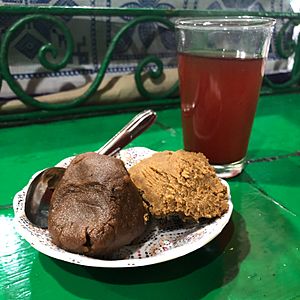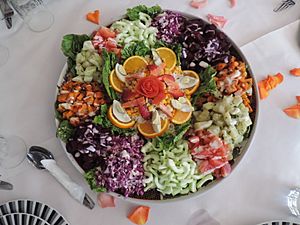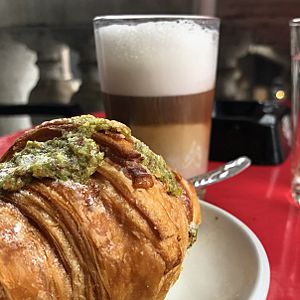Moroccan cuisine facts for kids
Moroccan cuisine is the traditional food from Morocco. It's a tasty mix of flavors from different cultures and countries that have connected with Morocco over many years. You'll find influences from Arab, Berber, Andalusi, and Mediterranean foods. There are also small hints of European (like French and Spanish) and sub-Saharan African styles.
Moroccan food is more similar to Middle Eastern cuisine than to other foods from Africa. Some experts, like Moroccan chef Hossin Houari, say that the oldest parts of Moroccan cooking we still see today go back to the 7th century BC.
Contents
What Makes Moroccan Food Special?
Morocco grows many delicious fruits and vegetables, like those found around the Mediterranean Sea. They also have some tropical foods. Common meats include beef, goat, lamb, and chicken. Seafood is also very popular.
Special flavors come from ingredients like lemon pickle, argan oil, and a type of preserved butter called smen. Olive oil and dried fruits are also important.
The main grains used today are rice and wheat. These are used to make bread and couscous. Long ago, barley was a very important food, especially in southern Morocco. Grapes are usually eaten fresh as a dessert.
Traditional cooking fats were butter and animal fat. Now, olive oil is often used instead. Butter is used fresh (called zebeda) and preserved (called smen).
Spices and Herbs
Spices are super important in Moroccan food! Many spices came to Morocco from Arab countries, bringing flavors from Persian and Arabic cooking. But many ingredients are grown right in Morocco. For example, saffron comes from Talaouine, mint and olives from Meknes, and oranges and lemons from Fes.
After the Idrissid family started the city of Fes in 789 AD, many spices arrived from the East. Some common spices you'll find are cinnamon, cumin, turmeric, ginger, paprika, coriander, saffron, mace, cloves, fennel, anise, nutmeg, cayenne pepper, fenugreek, caraway, black pepper, and sesame seeds. A special Moroccan spice mix called ras el hanout can have up to twenty-seven different spices!
Common herbs in Moroccan cooking include mint, parsley, coriander, oregano, peppermint, marjoram, verbena, sage, and bay laurel.
How Moroccan Meals Are Eaten
A typical lunch in Morocco often starts with different hot and cold salads. After that, people usually eat a tagine or dwaz. For special meals, a lamb or chicken dish might be served next. Then comes couscous with meat and vegetables.
Traditionally, Moroccans eat with their hands and use bread to scoop up their food. Because of religious rules, eating pork and drinking alcohol are not common.
Popular Moroccan Dishes
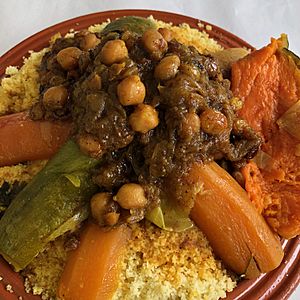
The most famous Moroccan dish is couscous. Beef is the most common red meat eaten in Morocco. It's usually cooked in a tagine with many different vegetables. Chicken is also very popular in tagines or roasted. Chefs often add ingredients like plums, boiled eggs, and lemon to these dishes. Tagines have a special taste from spices like saffron, cumin, cinnamon, ginger, cilantro, and ground red pepper.
Morocco has a long coastline along the Atlantic and Mediterranean seas. This means there are lots of delicious seafood dishes! European pilchards are caught in large numbers. Other fish include mackerel, anchovy, sardinella, and horse mackerel.
Other famous Moroccan dishes are pastilla (a savory pastry), tanjia (a slow-cooked meat dish), and rfissa (a dish with shredded bread, lentils, and chicken).
Bread is a big part of every meal. Moroccan bread is mostly made from a type of wheat called durum wheat semolina, known as khobz. Bakeries are everywhere in Morocco, and fresh bread is a must-have in every city, town, and village. The most common types are whole-grain or white-flour bread, and baguettes. There are also many flatbreads and pan-fried breads.
Moroccans also use dried and salted meats like khlea and g'did (which is like sheep bacon). These are used to add flavor to tagines or in el rghaif, a folded savory Moroccan pancake.
Soups and Salads
Harira is a popular, hearty soup. It's often eaten in winter to stay warm and is usually served for dinner. People often eat it with plain bread or dates, especially during the month of Ramadan. Bissara is another soup made from broad beans. It's also eaten during colder months.
Moroccan Salads can be made with raw or cooked vegetables, and served hot or cold. Some famous ones include zaalouk, which is a mix of aubergine and tomato. Taktouka is another popular salad made from tomatoes, smoked green peppers, garlic, and spices. It's common in the cities of Taza and Fes. Another cold salad is bakoula or khoubiza, made from cooked mallow leaves. It can also be made with spinach or arugula, and flavored with parsley, cilantro, lemon, olive oil, and olives.
Sweet Treats
Usually, fresh seasonal fruits are served at the end of a meal instead of cooked desserts. One common dessert is kaab el ghzal (meaning gazelle ankles). This is a pastry filled with almond paste and topped with sugar.
Another sweet treat is halwa chebakia. This is a pretzel-shaped dough that's deep-fried, soaked in honey, and sprinkled with sesame seeds. It's often eaten during Ramadan. Jowhara is a special dessert from Fes. It's made with fried waraq pastry, cream, and toasted almond slices. Coconut fudge cakes, called 'Zucre Coco', are also popular.
Seafood in Moroccan Cuisine
Morocco has a very long coastline, over 3,000 kilometers! This means there's a lot of fish in the waters. The sardine is very important for business, and Morocco is the world's largest exporter of sardines. In ancient times, sardines were even used to make a sauce called garum in the city of Lixus.
At Moroccan fish markets, you can find many kinds of seafood. These include sole, swordfish, tuna, turbot, mackerel, shrimp, conger eel, skate, red snapper, spider crab, lobster, and many different shellfish.
In Moroccan cooking, seafood is used in dishes like tagines, bastilla, briouat (small fried pastries), and even paella.
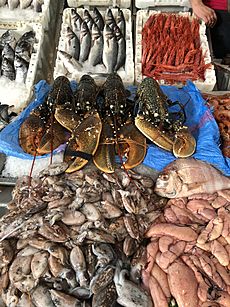
Popular Moroccan Drinks
The most popular drink in Morocco is Moroccan mint tea, called atay. Making good mint tea is seen as an art form in Morocco. Drinking tea with friends and family is a daily tradition. The way the tea is poured is just as important as the tea's quality. Moroccan teapots have long, curved spouts, which let the tea be poured from a height into small glasses. This creates bubbles, which Moroccans like. For the best taste, glasses are filled in two steps. The tea is usually served with hard sugar cones or lumps.
Morocco has many oranges and tangerines, so fresh orange juice is easy to find and not expensive.
Snacks and Street Food
Selling fast food on the street has been a tradition for a long time in Morocco. A great example is Djemaa el Fna square in Marrakech. Ma'quda is a potato fritter that's popular with students and people looking for an affordable meal, especially in Fes.
Since the 1980s, new snack restaurants, mostly in northern Morocco, started serving bocadillos. This is a Spanish word for a sandwich.
Dairy product shops, called mhlaba, are very common all over the country. These shops usually sell all kinds of dairy products, juices, smoothies, and local foods like bocadillos, msemmen (a type of flatbread), and harcha (a semolina pancake).
The khanz u-bnīn (meaning "stinky and delicious") is a cheap and popular street sandwich.
Another popular street food in Morocco is snails. They are served in their cooking liquid in small bowls and eaten with a toothpick.
In the late 1990s, several big international fast-food franchises opened restaurants in major Moroccan cities.
Famous Moroccan Chefs
Some people have helped share Moroccan cuisine with more people around the world. These include TV chef Choumicha and Al-Amīn al-Hajj Mustafa an-Nakīr, who was the chef for the former king of Morocco, Hassan II.
Images for kids
-
Location of Morocco
See also
 In Spanish: Gastronomía de Marruecos para niños
In Spanish: Gastronomía de Marruecos para niños


